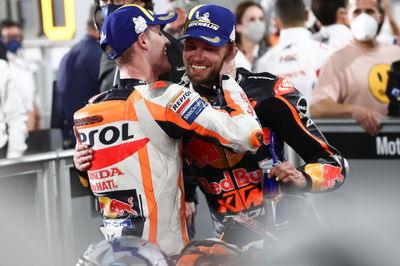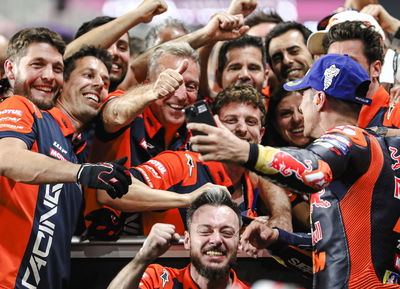KTM ‘underrated’ impact of losing MotoGP concessions, how will Aprilia fare?
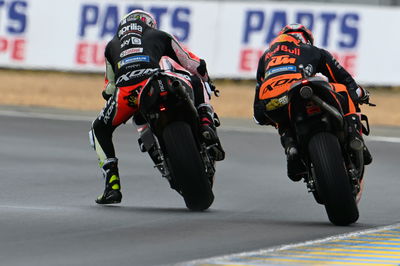
Suzuki and KTM have previously graduated out of the concession system, which grants technical perks including private testing with race riders and exemption from the in-season engine design freeze until six ‘concession points’ (based on podiums) have been achieved.
But in both cases, Suzuki and KTM suffered a drop in results the following season.
- KTM: Batteries not the ‘near future’ of motorcycles, against hybrids in MotoGP
- Jack Miller on ‘amazing’ MotoGP triple win attempt: ‘We’ll give it a crack’, ‘first quarter crucial’
- Watch: Valentino Rossi back on two-wheels at Portimao
Suzuki first left concessions in 2017, following four podiums – including one victory – for Maverick Vinales the previous year. But the inability to change the engine design hit the Hamamatsu factory hard when engine changes produced persistent handling problems.
New riders Andrea Iannone and Alex Rins failed to take a single podium that year, meaning Suzuki became eligible for concessions once again in 2018 (a rule that still exists).
The factory learned from its earlier engine mistake and remained out of concessions from 2019 until its MotoGP departure at the end of last season.
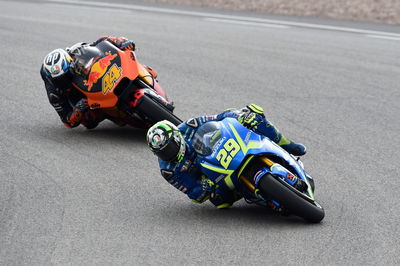
‘We definitely underrated the impact’
KTM, which made its full-time MotoGP debut in 2017, broke out of concessions after eight podiums, including three wins, during the 2020 campaign. Pol Espargaro was also fifth in the world championship.
But it remains the peak of KTM’s MotoGP success, with the Austrian factory scoring two wins and four podiums in both 2021 and 2022, when lead rider Brad Binder was sixth in the standings.
“Losing the concessions was already a while ago but it’s something where we definitely underrated the impact, that overnight you don’t have our race guys any more to test,” said KTM motorsports director Pit Beirer.
“Then if you want to finalise something you need to test with your race guys, in a race weekend on a Friday morning. You kind of mess up the weekend to do stuff like that.
“We did that much less last season, but in the years before I think we brought like 6-7 different chassis over a season and if chassis #7 didn’t work that well then we thought ‘ah, there was some advantage with chassis #4, let’s go back to that’.”
Realising such distractions were putting them on the back foot from Friday morning, KTM began restructuring its project in the winter of 2021-2022, to try and ensure only proven updates reached the race team.
“Last year we brought one new chassis, for the last race in Valencia, but this was very well tested by Dani [Pedrosa] and the team on different tracks,” Beirer said.
“We brought it for Brad, it was a success and he had a super strong race. But it was still a ‘little earthquake’ [introducing it] during Friday and Saturday, until he knew how the new chassis was working.
“So you need to do less of that if you want to succeed, but on the other side you need to make steps or you won’t move forward; this will always be a challenge for us, to find the right mix.
“You cannot lean back too long and stick with the existing bike because if you look at the lap times they are not only going faster every year, but sometimes even from race-to-race.”
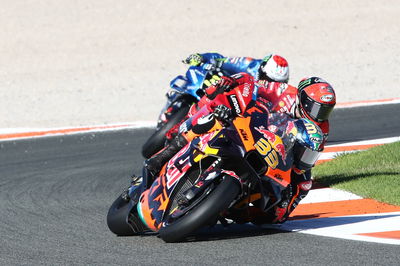
MotoGP gets faster 'every two months'
The relentless pace of development and bike improvements means Beirer believes MotoGP gets noticeably faster every two months.
“I would say in two months it shifts and you see the field is getting stronger, so you also need to bring something otherwise you drop backwards,” said the former motocross grand prix star.
“But definitely [we bring] much less than we did in our upcoming [growing] period and that’s better for the riders because there is a lot going on around them.”
The addition of Sprint races on Saturday afternoons, and the corresponding loss of FP4, means the intensity of MotoGP race weekends will also go up a notch.
“The Sprint race will not make it easier either, because now you need to be ready earlier in the weekend to go racing. So less testing time before a race, but that’s difficult because sometimes you need to test at the race,” Beirer said.
“At the Valencia test, people were asking us about the lap times after two hours, but you cannot look at a lap time at a one-day test right after the season.
“There are so many different parts that you need to use all four riders just to get an answer on them.
“Then, based on the test team and the one day with your race guys, you produce a lot of very expensive material for the new season.
“That is a very tough challenge for all the engineers in the paddock. Not just for us, for everybody, but that’s the game we like.”
Aprilia became the last of the current manufacturers to emerge from concessions after scoring ten podiums, including one win, over the past two seasons.
Unlike in the case of Suzuki and KTM, whose bike numbers remained the same after losing concessions, the Italian factory will gain extra data this season thanks to a new satellite partnership with RNF.
